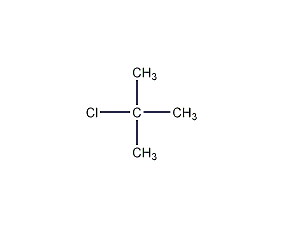
Structural formula
| Business number | 059W |
|---|---|
| Molecular formula | C4H9Cl |
| Molecular weight | 92.57 |
| label |
tert-butane chloride, tert-butyl chloride, 2-Chloro-2-methylpropane, Trimethylchloromethane, 2-Chloro-2-methylpropane, (CH3)3CCl, Halogenated hydrocarbon solvents, For synthesis of spices and pesticides |
Numbering system
CAS number:507-20-0
MDL number:MFCD00000816
EINECS number:208-066-4
RTECS number:None
BRN number:1730872
PubChem number:24846213
Physical property data
1. Properties: colorless and transparent liquid.
2. Boiling point (ºC, 101.3kPa): 50.7
3. Melting point (ºC): -25.4
4. Relative density (g/mL, 20/4ºC): 0.8420
5. Refractive index (n20ºC): 1.3857
6. Viscosity (mPa·s, 15ºC): 0.543
7. Flash point (ºC, closed): -5
8. Heat of evaporation (KJ/mol, b.p.): 27.42
9. Heat of fusion (KJ/mol): 2.09
p>
10. Heat of formation (KJ/mol, 25ºC, liquid): 179.99
11. Heat of combustion (KJ/mol, 25ºC, gas): 2682.1
12 . Specific heat capacity (KJ/(kg·K),-13.5ºC, constant pressure): 1.65
13. Conductivity (S/m, 30ºC): <10-7 ~10-10
14. Vapor pressure (kPa, 32.6ºC): 53.33
15. Volume expansion coefficient (K-1,0~30ºC): 0.00145
16. Solubility: Slightly soluble in water, miscible with alcohol and ether.
17. Relative density (25℃, 4℃): 0.8361
18. Refractive index at room temperature (n25): 1.3828
Toxicological data
Oncogenic data: Mouse intraperitoneal TDLo: 3000 mg/kg/8W-I, RTECS standard for tumors, causing lung, chest or respiratory system-tumors.
Ecological data
This substance may be harmful to the environment, and special attention should be paid to water bodies.
Molecular structure data
1. Molar refractive index: 25.39
2. Molar volume (cm3/mol): 105.9
3. Isotonic specific volume (90.2K ): 224.8
4. Surface tension (dyne/cm): 20.2
5. Polarizability (10-24cm3): 10.06
Calculate chemical data
1. Reference value for hydrophobic parameter calculation (XlogP): 1.8
2. Number of hydrogen bond donors: 0
3. Number of hydrogen bond acceptors: 0
4. Number of rotatable chemical bonds: 0
5. Number of tautomers: None
6. Topological molecule polar surface area 0
7. Number of heavy atoms: 5
8. Surface charge: 0
9. Complexity: 25.1
10. Number of isotope atoms: 0
11. Determine the number of atomic stereocenters: 0
12. Uncertain number of atomic stereocenters: 0
13. Determine the number of chemical bond stereocenters: 0
14. Number of uncertain chemical bond stereocenters: 0
15. Number of covalent bond units: 1
Properties and stability
Use and store according to specifications, no decomposition will occur, and avoid contact with oxides. In case of open flame, high heat energy will burn and decompose to release toxic gases. The chlorine atom in 2-chloro-2-methylpropane is very reactive and prone to hydrolysis or alcoholysis reactions. Shake with water at room temperature or heat to reflux to generate tert-butyl alcohol. Condensation reactions easily occur with aromatic hydrocarbons or phenol. For example, it reacts with benzene in the presence of aluminum trichloride to form tert-butylbenzene. It reacts with phenol in the presence of anhydrous hydrogen fluoride to form p-tert-butylphenol. When heated to above 300°C in the presence of a catalyst, it decomposes into isobutylene and hydrogen chloride.
Storage method
Stored in a cool, dry and well-ventilated warehouse. Keep away from fire and heat sources. Protect from direct sunlight. The packaging is sealed. They should be stored separately from acids and food chemicals, and avoid mixed storage. Suitable materials should be available in the storage area to contain spills.
Synthesis method
1. Obtained from the reaction of tert-butyl alcohol and hydrochloric acid. Add tert-butyl alcohol to hydrochloric acid under stirring at 30°C and react for 1 hour. Leave to stand and separate into layers. Take the oil layer and wash it with alkali, water, and dry to obtain a crude product. After rectification, collect the 50-54.5°C fraction to obtain the finished product.
2. Preparation method:
![]()
In a reaction bottle equipped with a stirrer, add 74g (1.0mol) of tert-butyl alcohol (2) and 250mL (3mol) of concentrated hydrochloric acid, and stir for 3 hours at room temperature. Pour the reactants into a separatory funnel and let stand to separate. The aqueous layer was separated, and the organic layer was washed three times with ice-cold water, then with ice-cold saturated sodium bicarbonate, and dried over anhydrous sodium sulfate. Fractionate and collect fractions 50 to 52. Then use the dried light calcium carbonate to remove the acidity and filter to obtain tert-butane chloride ① (1) 72~82g, with a yield of 78%~88%. Note: ①The reaction mechanism of this type of reaction is as follows. [1]

Purpose
It can be used to synthesize fragrance xylene musk, and can also be used to synthesize pesticides and other fine chemical products.


